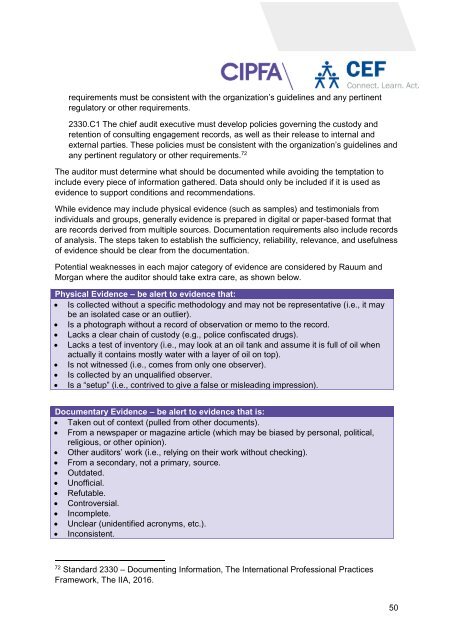Module 4 - Introduction to Performance Audit_4C
You also want an ePaper? Increase the reach of your titles
YUMPU automatically turns print PDFs into web optimized ePapers that Google loves.
equirements must be consistent with the organization’s guidelines and any pertinent<br />
regula<strong>to</strong>ry or other requirements.<br />
2330.C1 The chief audit executive must develop policies governing the cus<strong>to</strong>dy and<br />
retention of consulting engagement records, as well as their release <strong>to</strong> internal and<br />
external parties. These policies must be consistent with the organization’s guidelines and<br />
any pertinent regula<strong>to</strong>ry or other requirements. 72<br />
The audi<strong>to</strong>r must determine what should be documented while avoiding the temptation <strong>to</strong><br />
include every piece of information gathered. Data should only be included if it is used as<br />
evidence <strong>to</strong> support conditions and recommendations.<br />
While evidence may include physical evidence (such as samples) and testimonials from<br />
individuals and groups, generally evidence is prepared in digital or paper-based format that<br />
are records derived from multiple sources. Documentation requirements also include records<br />
of analysis. The steps taken <strong>to</strong> establish the sufficiency, reliability, relevance, and usefulness<br />
of evidence should be clear from the documentation.<br />
Potential weaknesses in each major category of evidence are considered by Rauum and<br />
Morgan where the audi<strong>to</strong>r should take extra care, as shown below.<br />
Physical Evidence – be alert <strong>to</strong> evidence that:<br />
Is collected without a specific methodology and may not be representative (i.e., it may<br />
be an isolated case or an outlier).<br />
Is a pho<strong>to</strong>graph without a record of observation or memo <strong>to</strong> the record.<br />
Lacks a clear chain of cus<strong>to</strong>dy (e.g., police confiscated drugs).<br />
Lacks a test of inven<strong>to</strong>ry (i.e., may look at an oil tank and assume it is full of oil when<br />
actually it contains mostly water with a layer of oil on <strong>to</strong>p).<br />
Is not witnessed (i.e., comes from only one observer).<br />
Is collected by an unqualified observer.<br />
Is a “setup” (i.e., contrived <strong>to</strong> give a false or misleading impression).<br />
Documentary Evidence – be alert <strong>to</strong> evidence that is:<br />
Taken out of context (pulled from other documents).<br />
From a newspaper or magazine article (which may be biased by personal, political,<br />
religious, or other opinion).<br />
Other audi<strong>to</strong>rs’ work (i.e., relying on their work without checking).<br />
From a secondary, not a primary, source.<br />
Outdated.<br />
Unofficial.<br />
Refutable.<br />
Controversial.<br />
Incomplete.<br />
Unclear (unidentified acronyms, etc.).<br />
Inconsistent.<br />
72<br />
Standard 2330 – Documenting Information, The International Professional Practices<br />
Framework, The IIA, 2016.<br />
50
















